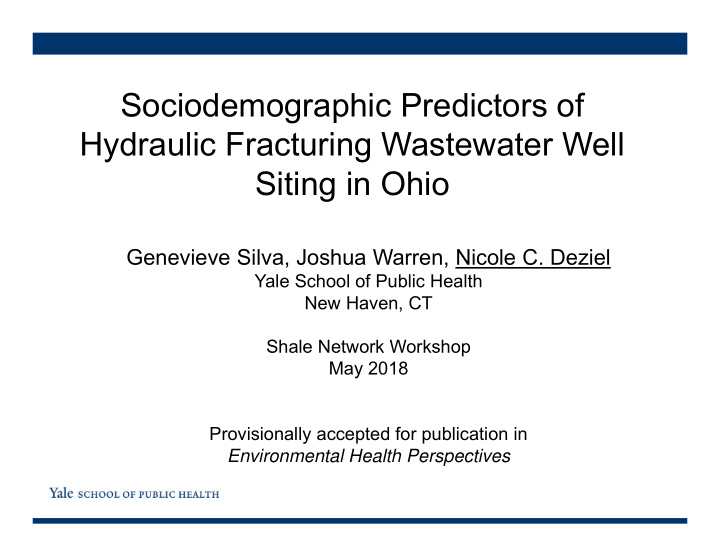



Sociodemographic Predictors of Hydraulic Fracturing Wastewater Well Siting in Ohio Genevieve Silva, Joshua Warren, Nicole C. Deziel Yale School of Public Health New Haven, CT Shale Network Workshop May 2018 Provisionally accepted for publication in Environmental Health Perspectives
UO&G Development is Water Intensive 7.5 to 49.2 million liters water used per well (Rodriguez 2015) 1.7 to 14.3 million liters waste water generated per well (Kondash 2017) ~100,000 UO&G wells in the U.S. (Czolowski 2017) www.water.usgs.gov
Waste Water Constituents • Brine • Radioactive materials, hydrocarbons, shale minerals, dissolved solids, metal ions • Residual fracturing fluids • Reproductive and developmental toxicants, carcinogenic compounds, endocrine disruptors, other toxicants (Elliott 2017a, 2017b; Stringfellow 2014, Kassotis 2016)
Class II Injection Wells • Primary method of disposal • Designed for brine, not hazardous waste • Link to seismic activity (Ellsworth 2013; Frohlich 2011; 2014; Horton 2012; Kim 2013; McGarr 2015; Rubinstein 2015) • Some evidence of water impacts (Akob 2016; Kassotis 2016) Ohio CII Injection Well Site; Source: FracTracker.org
Possible Contamination Pathways
Environmental Justice • History of disproportionately siting hazardous waste in vulnerable communities (Brown 1995; Bullard 1993; Agyeman 2016) • Little known about siting of CII wells – Disproportionately permitted in areas with ↑ minority populations and poverty in Texas (Johnston et al. 2016)
Objective • Evaluate relationship between presence of CII injection wells and sociodemographic characteristics in Ohio
Ohio Utica (red), Marcellus (yellow), UO&G well locations both (orange) shales ~2400 shale gas wells drilled in Ohio
CII Injection Wells in Ohio • 257 CII injection wells for waste disposal across its 9,238 block groups, 2010-2016 • Receives waste from Pennsylvania
Methods Unit of Analysis – Census block group Outcome – Presence of CII injection well (FracTracker Alliance) Sociodemographic Factors & Civic Engagement – Income, age, race, education, population density, voter turnout (US Census Bureau; Ohio State Department) Shale Gas Covariates – Shale gas well coordinates (Ohio Department of Natural Resources) – Marcellus and Utica Shale boundaries (US Energy Information Administration) Sparse Spatial Generalized Linear Mixed Model – Examine predictors of interest while accounting for spatial correlation and spatial confounding (Hughes and Haran 2013) – Bayesian framework
How Predictors Relate to Environmental Justice and Social Vulnerability • Fair treatment: no group disproportionately bears negative environmental consequences resulting from industrial, governmental and commercial operations or policies. • Meaningful involvement : people have an opportunity to participate in decisions about activities that may affect their environment and/or health. • Sociodemographic predictors are proxies for limited financial resources to fund better medical care, legal power, infrastructure, or relocation; decreased knowledge about environmental exposures; and limited access to resources to advocate on one’s behalf or mobilize political change (Institute of Medicine 2003; Molitor et al. 2011; Morello-Frosch et al. 2011; Solomon et al. 2016; Su et al. 2012).
Sociodemographic Factors by CII Injection Well Status Median (IQR) CII Well within Block No CII Well within Characteristic Group ( n =156) Block Group ( n = 9,049) Median age (years)* 43 (40–48) 40 (334–46) Population density (person/mi 2 )* 71 (40–160) 2,210 (433–4,750) Median income ($) 49,100 (41,000–57,000) 46,300 (33,100–62,000) % ≥ High school educated 89 (84–93) 90 (83–95) % White only* 98 (95–100) 92 (75–98) % Voter turnout* 72 (68–75) 72 (64–76) Median household value ($) 119,000 (91,600–148,000) 109,800 (78,600–154,000) * p<0.05 for t-tests
Odds of Class II Injection Well Presence 5.1 (2.8, 8.4) Utica shale (Yes vs. No) 2.6 (1.3, 4.5) Marcellus shale (Yes vs. No) 0.03 (0.008, 0.07) Population density (per 1,000 person/mi 2 ) 0.84 (0.72, 0.96) Median income (per $10,000) UNG well (per 1 count) % ≥ High school educated (per 1%) Median age (per 1 year) % White only (per 1%) % Voter turnout (per 1%) Water area (per 1 km 2 ) 0.001 0.01 0.1 1 10 Odds Ratio (95% CI)
Multivariable Modeling Results Block groups with at ≥1 CII injection well: • had lower median income • fewer UNG wells • were more likely to be located on a shale • had substantially lower population densities • No associations with education, age, race, voter turnout
Discussion • We can’t establish temporality or intentionality • Race was a difficult predictor to examine, due to the overwhelming majority of White only populations across block groups
Conclusions • Class II injection wells are disproportionately sited in regions of lower median income in Ohio • Research needed to understand whether these vulnerable populations face increased chemical exposures or adverse health effects due to proximity to these disposal facilities
Recommend
More recommend